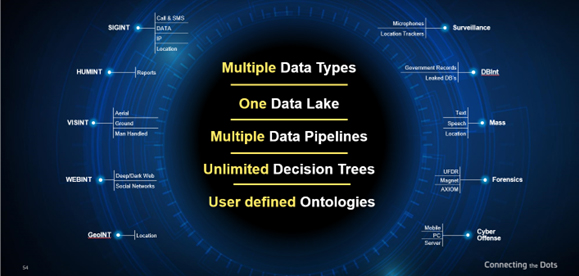A 360° View of Intelligence
This advanced system offers a robust solution to a burning issue: using AI to sift through vast amounts of data and extract valuable insights
The unprecedented volume of data flooding the world today poses a major challenge for security organizations as they strive to create clear intelligence pictures for their defense forces.
Online media, personal communication channels like phones and computers, and sophisticated weaponry are generating vast amounts of information. This flood of data requires intelligence organizations to rapidly scan, analyze, and interpret it. But how can they overcome these new challenges to produce a high-quality intelligence picture that effectively aids decision-makers?
Elbit Systems’ C4I and Cyber Division has addressed this need with an operational product that leverages artificial intelligence and machine learning: The i360 – Multi source, multi datatype investigation platform.
Innovating Systems and Humans
Elbit Systems’ C4I and Cyber Division’s solution, already in operation within several intelligence branches and security agencies worldwide, aims to effectively consolidate the vast amounts of data received by intelligence desks into a unified display on a single screen.
“The fields of intelligence and cyber are advancing at a breakneck pace,” says Yoav, Head of the Intelligence and Cyber Business Unit at Elbit Systems’ C4I and Cyber Division. “As the volume of information continues to rise, the demand for AI systems to process and organize this data is growing exponentially,” he explains.
“In the past, to understand the open-source intelligence picture in a particular country, you could rely on a few articles from a popular newspaper to generate a report. Today, that’s no longer the case” Yoav continues.
He emphasizes that no single intelligence analyst, nor a significant size group of analysts, can sift through such vast amounts of material. A digital, AI-based system is necessary to navigate these massive data sets, identify anomalies, and highlight changes worthy of attention.
This is where the i360 system comes into play. It allows intelligence officers and operational teams to query a vast array of information, extracting high-quality insights. “You can ask this system almost any question, and it will sift through massive amounts of data from various sensors and sources – whether it’s VISINT, SIGINT, COMINT, ELINT, HUMINT, or OSINT – running sophisticated algorithms to detect suspicious or intelligence-relevant activities,” adds Yoav.

The i360’s Triad of Elements
Clearly, executing this mission requires substantial technological and processing capabilities. But what’s the secret behind the system’s ability to produce high-quality intelligence recommendations? According to Yoav, it’s a combination of three important criteria.
The first element is a dynamic database. “Within the intelligence picture, numerous entities or ontologies are collected,” Yoav explains. “These ontologies require a comprehensive set of criteria to be classified accurately. For instance, if we’re dealing with an entity like a person or a terrorist organization operative, the system gathers information such as their height, weight, eye color, place of residence, and when they were last seen. But what do you do if along the way you want to add data field to the “Person” entity? Data like relation to other members of the organization or even if they own a car and what model.”
“In a traditional, legacy systems, modifying or adding new entities may jeopardize the system operation!! i360 was designed to maintain system integrity enabling quick and accurate data retrieval while adding and modifying the database structure.
The second element of the i360 system is its ability to generate complex decision trees on the fly. Fundamentally, a decision tree as an intelligence question “Suppose I want to track the movement and behavior of an enemy battalion,” Yoav explains. “For example, if an intelligence officer queries the system about anomalies in the movement of that battalion, the system operates according to defined decision trees to adequately answer the question.”
He continues, “The initial query splits into several sub-questions. If the battalion moved – was it an unusual movement? When was the last time they moved like this? Is this movement influenced by the battalion’s training schedule? When was the last time it deployed in such areas?” These complex decision trees help the system thoroughly process the information it receives, transforming it into an actionable intelligence report backed by data.
The third element is the ability to orchestrate this process, “generation an AI Pipelines” that helps answer the question in a single decision tree. Every item of information will go through the relevant AI pipeline, data will be vectorized and indexed on the fly, allowing the system to query the data and answer the “Decision Tree” questions.
“Ultimately” adds Yoav, “it is all about collecting and fusing multiple data types from multiple data sources, navigating complex decision trees based on AI Pipelines and finally creating the intelligence picture, recommendation or alerts.”
Not For Military Use Only
This system isn’t limited to military security organizations; it’s already being utilized by National Intelligence and security agencies, as well as police units and law enforcement agencies across the globe.
The content of the article does not constitute business or financial information about Elbit Systems Ltd. (the “Company”) and is not intended to be a basis for making investment decisions in the Company’s securities. In order to obtain business or financial information about the Company, please refer to the reports and filings that the Company regularly publishes on the website of the U.S Securities and Exchange Commission (EDGAR) and on the notification system of the Tel Aviv Stock Exchange (Maya).
The article may contain forward-looking statements such as estimates, forecasts, estimates, plans, etc. that refer to future events that are considered forward-looking information as defined under the securities laws of Israel and the United States. There is no certainty that such information will be realized, in whole or in part, and the actual result may differ from what was presented in the article, among other things due to its dependence on external factors that are not under the control of the Company and that cannot be evaluated in advance. The forward-looking statements are based on the Company’s estimates at the time of publication, and the Company has no obligation to update or correct this data.



